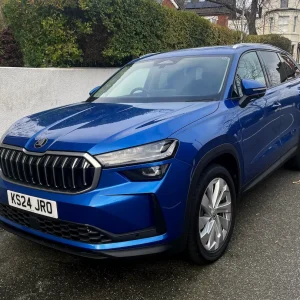The initial arrival of the Skoda Scala in 2019 was something of a surprise, since as a lower-medium hatch it seemed to tread on the toes of Skoda’s existing contender in that segment, the Octavia. The main difference between them in mechanical terms is that while the Octavia shares the Volkswagen Group’s MQB Evo platform with fellow lower-medium cars such as the VW Golf and Audi A3, the Scala uses the MQB A0 platform normally used for smaller cars, such as Skoda’s Fabia supermini and Kamiq small SUV, allowing it to represent a cheaper, smaller (yet still C-segment in size) alternative. We reviewed the facelifted Kamiq in the previous issue, and Skoda has also updated the Scala at the same time, with many similarities between the two upgraded models.
Exterior design changes with the facelifted Scala include front and rear bodywork styling tweaks and redesigned headlights, while matrix LED lighting is newly available as an option. Inside, an 8.25in infotainment screen and 8in driver display are now standard, with these increasing to 9.2in and 10.25in respectively on higher-spec models. The driver display gives a useful range of information including sat-nav instruments, and the overall infotainment set-up works well, including the climate controls, which have been tweaked to make them more user-friendly.
Interior materials including new dashboard cloth upholstery form part of the facelift, and with our European Selection-spec test car (closest to the mid-range SE L grade in the UK) Skoda has successfully lifted the ambience of the interior so it no longer feels conspicuously like a budget model.
Rear passengers don’t suffer because of the Scala’s small car platform, since they enjoy lots of legroom. A 473-litre boot is also impressive for the segment (though down on the Octavia) and offers a near-flat load lip.
As with the updated Kamiq, there are three petrol engines on offer, which have received some efficiency improvements – although from a fleet point of view it would have been nice to see an EV or hybrid option. We tried the most powerful 150hp, 1.5-litre engine, and found it pulled well on the road, while the six-speed manual gearbox shifts with a reasonably smooth action.
Perhaps the most noteworthy aspect of the Scala’s on-road performance is the quality of the ride, which is impressively supple. As for the handling, it corners reliably without being especially sporty – something we imagine most buyers will be happy to accept in exchange for the level of comfort on offer.
Skoda has come a long way since its days as a bargain basement budget brand, but the Scala proves it still knows how to offer good value for money. An equivalent version of Business Car’s reigning Best Family Car, the Vauxhall Astra (actually with a slightly less powerful engine), costs more than £3,500 more on P11D, and is expected to be around 4p per mile more expensive to run. The Scala does face tougher competition from the (also soon to be facelifted) Octavia, with an equivalent version working out less than 2p per mile more expensive according to our data provider DriveSmart. Many will probably feel that’s a price worth paying for the larger model’s extra practicality – but the upgrades to the Scala, although modest in some respects, help to make it an impressive package in its own right.
Skoda Scala 1.5 TSI SE L
P11D: £25,905
Residual value: 39.4%
Depreciation: £15,320
Fuel: £8,177
Service, maintenance and repair: £1,913
Cost per mile: 42.35p
Fuel consumption: 49.7mpg
CO2 (BIK %): 129g/km (30%)
BIK 20/40% a month: £130/£259
Luggage capacity: 467 litres
Engine size/power: 1,498cc/150hp





